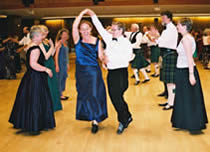RSCDS Brighton Branch
More about Scottish Country Dancing
 Scottish Country Dancing (SCD) is social dancing. It is suitable for adults and children, indeed the whole family can enjoy it together.
Scottish Country Dancing (SCD) is social dancing. It is suitable for adults and children, indeed the whole family can enjoy it together.
Scottish country dances are made up of a series of steps and formations that we learn in our weekly classes. The individual dances we have learned in class are assembled into programmes for fun social evenings and formal balls.
Jigs and Reels are faster dances, the elegant Strathspeys are slower. Scottish country dance also includes some hornpipes, medleys and quadrilles. The lively Celtic music inspires even beginners to fly joyously around the floor. We dance to driving strains played on the fiddle, accordion, flute, piano or drums - but rarely the bagpipes.
(If you thought it was danced to bagpipes and competitive, you are probably thinking of highland dancing which is a solo, display dance.)
Watch these Selected Videos of Scottish Country Dancing
- Reels - on the right, click on the triangular "play button" to watch the reel The Glen of Angus. To see the videos listed below, follow the blue links.
- A favourite reel locally is Polharrow Burn, performed in this video at an RSCDS Manchester ball.
- This video of the very popular reel The Irish Rover shows how we usually dress for Saturday dances.
- The Reel of the 51st Division was written by Scots prisoners of war in 1940 - there is a page about the history of this dance in the Extra Info section of its entry in my.strathspey.org.
- Some Scottish dances, especially recent ones, tempt musicians to devise interesting and playful music, such as Ramadan-ce, written by John Drewry in 2000. Have a look at the videos here on my.strathspey.org.
- Jigs - this jig called The Dancing Master is one of John Drewry's popular Scottish country dances.
- Medley - combines two speeds, usually a strathspey followed by a reel or jig - see this very professional display of the medley called Schiehallion by the Glasgow Scottish Country Dance Team on Come Dancing in 1992.
- Strathspey - A short example of a Strathspey, called Miss Jane Muirhead of Dunsmuir, and a longer video of Culla Bay, followed by Mary Hamilton. Strathspeys are a slower, more graceful style of dancing which allows us to carry out more complicated manoeuvres.
Dance structure
Generally we dance in sets of three or four couples usually facing each other in lines. Most dances are based around a selection from about 40 standard moves, figures or formations including: dance up and down the middle, turn or spin, poussette, right hands across, cast off, cast up, allemande, double triangles, teapots and setting to partner. Then there are the reeling movements: normal reels, diagonal reels, mirror reels, crossing reels, double crossing reels, Inveran reels, Schiehallion reels…The figures or formations that make up each dance
Although this may sound daunting at first, you quickly pick up most of the figures necessary to do the dances. There are about a dozen basic figures which will get you through quite a number of dances, although many dances have their own quirks and specialities which make them unique and fun to dance. It is this variety of figures that makes Scottish dancing so enjoyable. And it's easy to have a good time, most people love it from the beginning. There are always experienced dancers around willing to help you learn new figures, both in practice classes and at dances. Scottish Country Dancing is available world-wide, its popularity due to the way it combines aerobic fitness, skills and technique development, social interaction and teamwork, alertness and mental stimulation, as well as developing balance and poise. Also, as there are over 7,000 known dances and new ones constantly being written, there is no danger of coming to an end - there is always more challenge ahead to maintain interest and enjoyment for a lifetime.
Scottish Country Dancing is available world-wide, its popularity due to the way it combines aerobic fitness, skills and technique development, social interaction and teamwork, alertness and mental stimulation, as well as developing balance and poise. Also, as there are over 7,000 known dances and new ones constantly being written, there is no danger of coming to an end - there is always more challenge ahead to maintain interest and enjoyment for a lifetime.
Scottish Country Dancing is equally suitable for men and women, and was developed in a culture in which men took great pride in being fit and skilled dancers. Over 250 years ago foreign visitors were writing with surprise that the Scots were such enthusiastic dancers that they would quite happily “dance to a corner cupboard” until exhausted, purely for the pleasure obtained from their energetic dances and the lively, driving music. Ex-patriate Scots first took SCD abroad but now there are thriving Branches in Germany, Japan and elsewhere that were started by locals who just found it a great form of dancing.
SH, 2007
Scottish Country Dancing keeps you Fit and Healthy
Scottish country dancing is now recognised as a valuable activity for maintaining health and fitness. In August 2010, the University of Strathclyde carried out a study of seventy fit women between the ages of 60 and 85 years; half were Scottish country dancers and the remainder participated in other physical activities such as swimming, walking, golf and keep fit classes. The women were assessed on their strength, stamina, flexibility and balance. They all compared favourably with average fitness levels for women in their age range, but the Scottish country dancers were shown to have more agility, stronger legs, and to be able to walk more briskly than people who took part in other forms of exercise.See articles by the RSCDS The health benefits of SCD and The Scotsman, 12 January 2014, Scottish dancing can help keep old age at bay.
See also
RSCDS page What is Scottish country dance and music?RSCDS page about the History of Scottish Country Dancing
Brighton Branch links page, section headed About dances and dancing.
